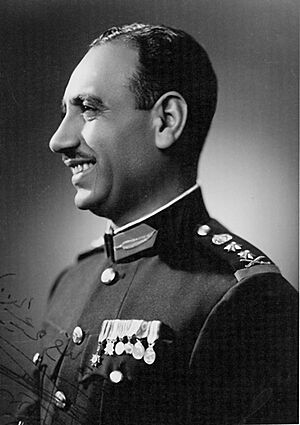Abdul Salam Arif facts for kids
Quick facts for kids
Abdul Salam Arif
|
|
|---|---|
|
عبد السلام عارف
|
|

Arif in the 1960s
|
|
| 2nd President of Iraq | |
| In office 8 February 1963 – 13 April 1966 |
|
| Prime Minister | Ahmed Hassan al-Bakr Tahir Yahya Arif Abd ar-Razzaq Abd ar-Rahman al-Bazzaz |
| Preceded by | Muhammad Najib ar-Ruba'i |
| Succeeded by | Abdul Rahman Arif |
| Personal details | |
| Born | 21 March 1921 Baghdad, Mandatory Iraq |
| Died | 13 April 1966 (aged 45) Basra Governorate, Iraqi Republic |
| Cause of death | Airplane crash |
| Political party | Arab Socialist Union |
| Military service | |
| Allegiance | |
| Branch/service | Iraqi Army |
| Rank | Colonel |
| Battles/wars | First Arab–Israeli War July 14 Revolution |
Abdul Salam Mohammed Arif al-Jumayli (born March 21, 1921 – died April 13, 1966) was the second president of Iraq. He served from 1963 until his death in a plane crash in 1966. Arif played a key role in the 14 July Revolution in 1958. This event led to the end of the Hashemite monarchy in Iraq.
Contents
Becoming a Leader in Iraq
Abdul Salam Arif was a member of a secret group called the Free Officers of Iraq. This group included other military officers like Abdel Karim Qasim. Arif was a brave soldier in the 1948 Arab–Israeli War. He helped capture a town called Jenin.
In the summer of 1958, Arif was ordered to move his troops to help Jordan. Instead, he led his army units into Baghdad. On July 14, he launched a coup (a sudden takeover of the government). This action ended the rule of the Hashemite monarchy.
After the coup, Qasim formed a new government for the republic. Arif became the deputy prime minister and interior minister. He was also the deputy commander-in-chief of the armed forces.
Disagreements and Arrest
Soon after, disagreements grew between Arif and Qasim. Arif wanted Iraq to join the United Arab Republic (UAR). The UAR was a union of Egypt and Syria led by President Gamal Abdel Nasser. However, Qasim, who was an Iraqi nationalist, did not want to join the UAR.
This led to a power struggle between the two leaders. Qasim won this struggle. Arif was removed from his positions on September 12. He was then given a less important job as an ambassador. Arif refused this job and returned to Baghdad. On November 4, he was arrested for planning against the government.
In February 1959, Arif was given a serious punishment. However, Qasim later released him in November 1961.
Leading Iraq as President

On February 8, 1963, Qasim's government was overthrown. This was done by a group of Ba'athists, army units, and other Arab nationalist groups. Arif had been chosen as the leader of the Iraqi Revolutionary Command Council. After this new coup, he was elected president of Iraq because he was popular.
Qasim asked Arif to let him leave the country instead of being punished. He reminded Arif that he had been kind to Arif before. But Arif asked Qasim to swear on the Qur'an that Arif was the true leader of the 1958 coup. Qasim refused, and was then executed.
Government Changes and Unity Efforts
Even though Arif was president, the Ba'athist leaders held more power. These included Ali Salih al-Sa'di and Prime Minister Ahmed Hassan al-Bakr. After a Ba'athist-led coup in Syria in March 1963, Arif started talks to unite Iraq with Syria and Egypt.
However, after a disagreement with Nasser in July, the Ba'athist government in Iraq removed all non-Ba'athist members from the government. Arif supported Nasser. On November 18, Arif used a split within the Ba'ath party to his advantage. He removed their members from the government.
Arif then formed a new government. It included some Ba'athists, but mostly army officers who supported Nasser and experts in various fields. He remained president and made himself chief-of-staff. A month later, he gave this role to his brother, General Abdul Rahman Arif. He also made his trusted friend, Lieutenant-General Tahir Yahya, the prime minister. In late 1964, the Ba'ath party tried to remove Arif from power. Their plan was discovered, and Arif had the people involved arrested.
On May 26, 1964, Arif created a Joint Presidency Council with Egypt. On July 14, the anniversary of the revolution, he announced the creation of the Arab Socialist Union (ASU) of Iraq. He said it was the start of building a united Arab nation under Arab socialism. This organization was very similar to Egypt's ASU. Many Arab nationalist parties were dissolved and joined the ASU. Also, all banks and over thirty large Iraqi businesses became owned by the government. Arif did these things to bring Iraq closer to Egypt and help create unity. Plans for a union were announced on December 20.
Despite these efforts, in July 1965, the ministers who supported Nasser resigned from the Iraqi government. President Arif played a big part in building and improving Iraq's roads and other important structures.
Death
On April 13, 1966, Arif died in a plane crash. His plane, a de Havilland DH.104 Dove 1, crashed in southern Iraq. It was about 10 kilometers from Basra Airport. His brother, Abdul Rahman Arif, took over as president.
Abd al-Rahman al-Bazzaz was acting president for three days. There was a struggle to decide who would be the next president. In the first meeting to choose a president, Al-Bazzaz needed a two-thirds majority to win. He did not succeed. Abdul Rahman Arif was then elected president. Army officers saw him as someone who would be easier to influence than his brother.
See also
 In Spanish: Abdul Salam Arif para niños
In Spanish: Abdul Salam Arif para niños

